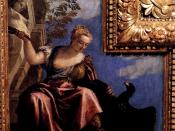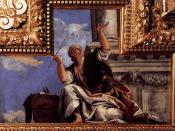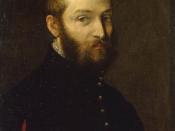Paolo Caliari, known as Veronese (1528-1588), was a highly successful Italian artist of the Venetian school during the High Renaissance. He is distinguished as one of the greatest Venetian decorative painters, combining styles of the High Renaissance with that of Mannerist. His Classical and Mannerist influences can be connected with the works of earlier artists such as Parmigianino, Romano, and Titian. As an active painter in Venice in 1553, Veronese developed his distinctive lavish use of color, which became recognized instantly. Known for showing ingenious patterns of illusionism, his paintings depicted landscapes, mythological scenes and portraits. (www.encyclopedia.com/html/v/veronese.asp)
Veronese is the creator of the magnificent "Triumph of Venice", an immense oval-shaped fresco located on the ceiling of the Hall of the Great Council in the Doges' Palace, Venice. Veronese was commissioned to work here as a ceiling painter, where he would master his skill and create the famous ceiling fresco.
He began work on the painting when he was hired in the redecoration of the Palace, which had set fire in 1577. We know that "he must have begun at some time between 1578 and 1585, since he has inserted the arms of Nicolo da Ponte, who was doge during those years" (Osmond 86). Veronese was allotted the three compartments of the ceiling to do his paintings, one of which would become the ever-popular "Apotheosis".
The most awe-inspiring of his ceilings, it is the "boldest sample of his abilities as a ceiling painter." (Priever 119). With its use of perspective, depth, color, and splendid architecture, it became one of the most popular works in the city. Painted from 1579-1582, it is oil on canvas, and stretches 904 x 580cm. It is set in a gold frame, and faces directly above the area where the Doge and his municipals seat.



Awesome
I think this is by standards an awesome essay the wording is perfect and information is plentiful. Another great aspect is the bibliography section which makes it a lot easier. Congrats!
1 out of 1 people found this comment useful.